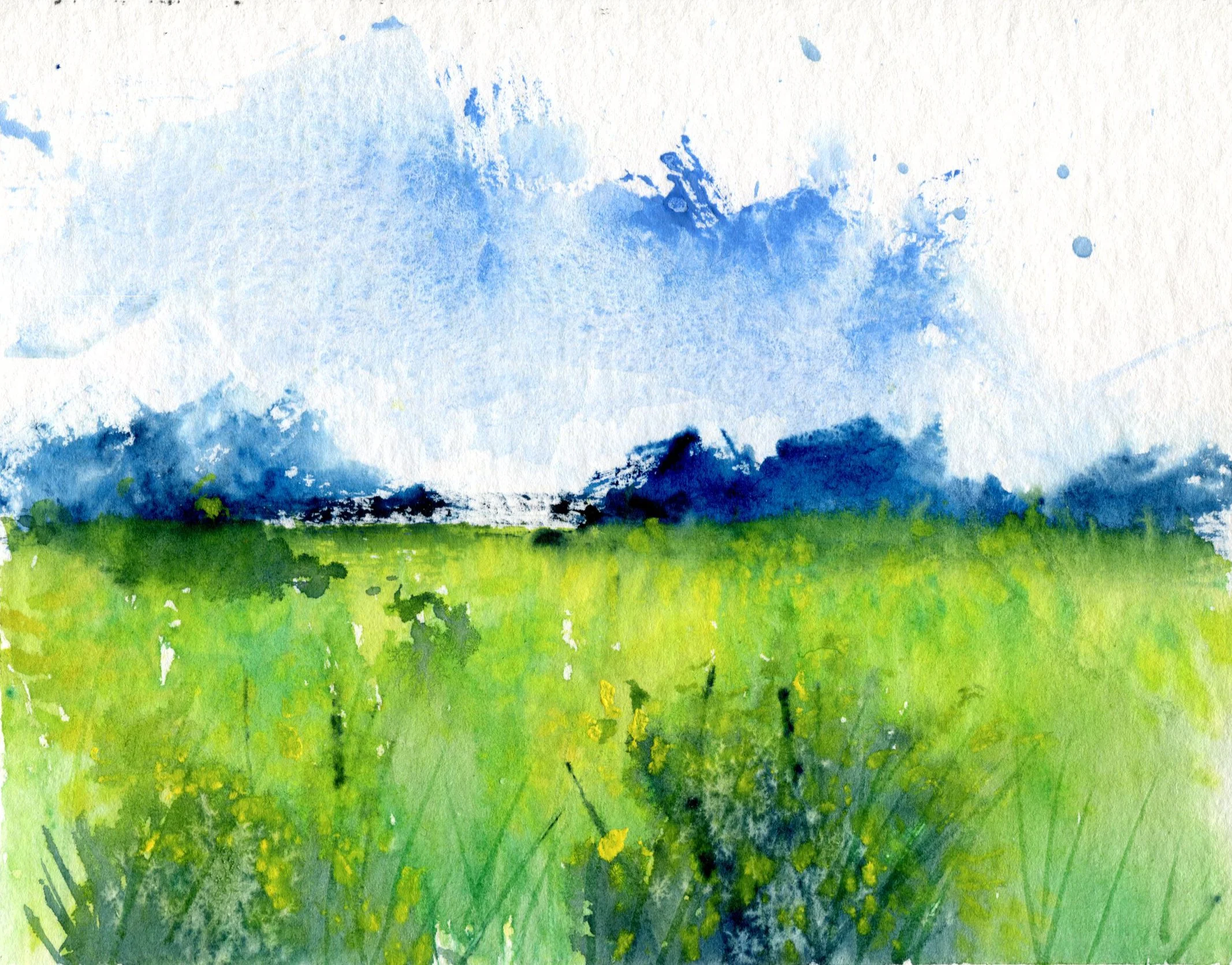Get started with Loose Watercolor Landscapes
In the late 1800s, a handful of young painters took their paints and canvases outdoors and began painting fleeting moments of light in bright, vivid colors. We know them today as the Impressionists. They painted in oil. I paint in watercolor. Two very different media. But the art of the Impressionists inspired me to create loose, bright watercolor landscapes. Below are some examples.
To create loose, impressionistic watercolor landscapes, you will need the following materials: paper, paint, a brush, a palette, a glass jar or other container to hold water, a wooden board, and tape to secure the paper while you are painting. Many top-quality brands exist, and all of them can deliver fantastic results, but I know some people are interested in what I use, so here is a list:
paper: Arches or Hahnemühle
brush: synthetic hair mop brush, small
paint: mostly Sennelier. I use tubes rather than pans
But please use whatever materials work best for you.
The Paint:
I use a limited palette of Sennelier watercolor paint. In other words, I only use a few colors. My spring and summer palette is Cobalt Blue, French Ultramarine Blue, Prussian Blue, and Cadmium Yellow Light. I prefer more earthy shades, such as Sepia and blues, for winter landscapes. As you start with watercolor, I advise limiting your palette to five or six colors at most. Why use a limited palette? I recommend using just a few colors for two reasons:
I like to keep my art spontaneous and fresh. Having fewer colors to work with makes it easier to choose which color to use, which in turn helps me work fast and keep it spontaneous.
Limiting your colors can produce a more harmonious composition and help create a more unified painting. Using too many colors might result in a discordant painting, which is fine if that is your goal, but many beginners feel they need to use all the colors and end up unhappy with the results.
Watercolor paint is often available in two forms: tubes and pans. Pans are small dried blocks of paint that are reactivated with a wet brush. I prefer to use tubes, but everyone has their own preference. I mostly use pure, unmixed paint for my paintings. Other people prefer to mix colors. Your choices about how to use color help to define your art style.
The Paper:
There are many types and brands of watercolor paper. Things to consider include the paper's composition, its weight and thickness, whether it is internally or externally sized, and whether the surface is rough or smooth.
The best watercolor paper is 100% cotton - it warps less than wood pulp paper.
I prefer paper that is at least 300 grams per square meter (140 pounds). Thinner paper is cheaper but will buckle as you add water and wet paint.
Watercolor paper can be internally or externally sized. Sizing is glue that makes the paper stronger and also slightly waterproof. Externally sized paper produces somewhat more vivid colors because the pigment does not sink as deeply into the paper. Note: Sizing may not always be vegan-friendly, so please check with the manufacturer.
Watercolor paper is available with different surface textures: rough (= cold pressed), smooth (= hot pressed), and NOT (slightly textured surface). Rough surfaces are suitable for looser styles.
Brushes:
I use just one brush, a small mop brush. Some people have an extensive collection of various brushes, but I prefer to keep things simple. When choosing a brush, always opt for one specifically designed for watercolor, rather than oil painting, acrylic, or any other medium. Many watercolor brushes are made from natural hair, but if you prefer, you can also get high-quality synthetic brushes. I prefer synthetic brushes.
Some more examples of my watercolor landscapes:
Where to start?
Once you have some painting materials you need to decide what to paint. Be realistic, start simple. A basic landscape using a limited palette. If you are using a photograph you need to simplify it, look past the details to the main shapes, the sky, the horizon, middle ground and foreground. Remember reference photographs are for reference only unless your style is photo realism you don’t need to include every detail. Look at the examples above, each of these paintings has just a few, usually less than five, components. For the first 20, 30 … 50 paintings focus on keeping things simple and developing your own style. This YouTube video may have some ideas that might help some people.
You can subscribe to my YouTube channel to get notified when I release a new video. I currently release a new video every week.
If you would like to follow my art journey, complete with its ups and downs, I have a Patreon page. There is a free tier and a paid tier for those who want some extra content. I also have a Patreon shop with a few items available, including a PDF booklet with many more examples of my art. It might be helpful for inspiration.
If you want to learn more about my approach to loose watercolor landscape painting, I have a book available on Amazon.
Follow the links below or search for Loose Modern Watercolor Landscapes by Paul O’Neill.






